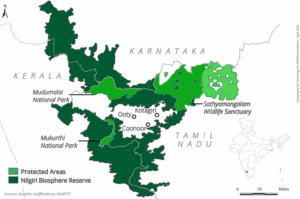The Nilgiri Biosphere Reserve (NBR) is one of the most important protected ecological zones in India. It was the first biosphere reserve established in India and forms part of the UNESCO World Network of Biosphere Reserves.

Key Facts
| Aspect | Details |
| Location | Spread across Tamil Nadu, Kerala, and Karnataka in the Western Ghats |
| Total Area | 5,520 sq. km |
| Established | 1986 – First biosphere reserve in India |
| UNESCO Recognition | Declared a UNESCO World Network of Biosphere Reserves site in 2000 |
| Altitude Range | 250 m to 2,650 m above sea level |
| Main Rivers | Bhavani, Moyar, Kabini, and Kundah |
| Climate | Tropical to subtropical with heavy monsoon rainfall |
Geographical Spread
The reserve covers parts of:
- Tamil Nadu – Nilgiris, Erode, and Coimbatore districts
- Kerala – Palakkad, Wayanad, and Malappuram districts
- Karnataka – Mysuru, Chamarajanagar, and Kodagu districts
Protected Areas within NBR
| State | Protected Areas |
| Tamil Nadu | Mudumalai Wildlife Sanctuary, Mukurthi National Park, Sathyamangalam Tiger Reserve |
| Kerala | Silent Valley National Park, Wayanad Wildlife Sanctuary |
| Karnataka | Bandipur Tiger Reserve, Nagarhole National Park, BR Hills Wildlife Sanctuary |
Flora
The Nilgiri Biosphere Reserve is part of the Western Ghats biodiversity hotspot and hosts diverse vegetation types:
- Tropical moist evergreen forests
- Montane Shola forests and grasslands
- Tropical dry deciduous forests
- Moist deciduous forests
Key plant species:
- Michelia nilagirica, Eucalyptus, Cinnamomum wightii, wild bananas, orchids, and many medicinal plants.
Unique Feature:
It is home to several endemic species, including the Neelakurinji (Strobilanthes kunthiana), which blooms once every 12 years.
Fauna
The reserve supports megafauna and endangered species.
Flagship species:
- Mammals: Asiatic elephant, Bengal tiger, leopard, gaur (Indian bison), sloth bear, Nilgiri tahr (endemic), wild dog (dhole).
- Birds: Malabar grey hornbill, great Indian hornbill, Malabar trogon.
- Reptiles: King cobra, Malabar pit viper.
- Primates: Lion-tailed macaque (endemic and critically endangered).
Ecological and Cultural Significance
- Biodiversity Hotspot:
- Hosts a rich variety of endemic flora and fauna, part of the Western Ghats global biodiversity hotspot.
- Corridor for Wildlife:
- Serves as a vital corridor for tiger and elephant movement between reserves like Bandipur, Nagarhole, and Mudumalai.
- Cultural Heritage:
- Home to indigenous communities, including Toda, Kota, Irula, and Kurumba tribes, who practice traditional agriculture and forest-based livelihoods.
- Watershed Role:
- Major source of water for peninsular rivers, supporting agriculture and drinking water needs for millions.
Conservation Challenges
- Deforestation and encroachment for agriculture and plantations.
- Poaching and illegal wildlife trade.
- Human-wildlife conflict, especially with elephants and tigers.
- Tourism pressure leading to habitat degradation.
- Climate change affecting montane ecosystems like Sholas and grasslands




